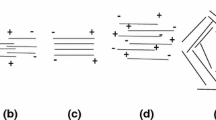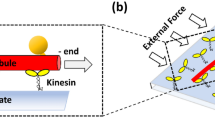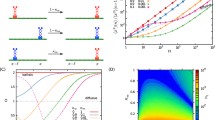Summary
The microtubule is a highly efficient vectorial structure that could orient a transport force generating mechanism and also absorb the recoil produced by vectorial force generation. We have assumed that a nonspecific shear force is generated in a narrow annulus around the microtubule and have calculated the velocity profiles in the shear flow and drag flow regions that result from such a mechanism. This circumtubular flow of low visocosity cytoplasm is thought to be the basic carrier stream that produces the observed axoplasmic transport phenomena. These carrier streams are devoid of neurofilaments and form the halos or exclusion zones seen around microtubules in electron micrographs. Individual carrier streams may merge hydrodynamically to produce transport domains that are capable of moving large organelles in a saltatory manner. Exchange of material between the low viscosity transport domains and the high macroviscosity neurofilament regions produces mass fluxes akin to those found in chromatographic columns. Calculations of energy required to maintain streaming and of the energy available to the transport system show a close correspondence and demonstrate that a continuous carrier stream activity is energetically feasible.
Similar content being viewed by others
References
Alonso, G., Gabrion, J., Travers, F., Assenmacher, I., 1981: Ultrastructural organization of actin filaments in neurosecretory axons of the rat. Cell Tiss. Res.214, 323–341.
Amos, L. A., 1975: Substructure and symmetry of microtubules. In: Microtubules and Microtubule Inhibitors (Borgers, M., De Brabander, M., eds.), pp. 21–34. Amsterdam: Elsevier/North-Holland Biomedical Press.
Bergmeyer, H. U., 1974: Methoden der Enzymatischen Analyse, Vol.2, pp. 2344–2346. Weinheim: Verlag Chemie.
Berlinrood, M., McGee-Russell, S. M., Allen, R. D., 1972: Patterns of particle movement in nerve fibersin vitro, an analysis by photokymography and microscopy. J. Cell Sci.11, 875–886.
Bernhardt, E. C., 1974: Processing of Thermoplastic Materials, p. 300. Huntington, N.Y.: R. E. Krieger Pub. Co.
Berthold, C. H., 1982: Some aspects of the ultrastructural organization of peripheral myelinated axons in the cat. In: Axonal Transport (Weiss, D. G., ed.), pp. 40–54. Berlin-Heidelberg-New York: Springer.
Bird, R. B., Stewart, W. E., Lightfoot, E. N., 1960: Transport Phenomena. New York: Wiley.
Black, M. M., Lasek, R. J., 1980: Slow components of axonal transport: two cytoskeletal networks. J. Cell Biol.86, 616–623.
Breuer, A. C., Christian, C. N., Henkart, M., Nelson, P. G., 1975: Computer analysis of organelle translocation in primary neuronal cultures and continuous cell lines. J. Cell Biol.65, 562–576.
Brimijoin, S., 1979: On the kinetics and maximal capacity of the system for rapid axonal transport in mammalian neurones. J. Physiol.292, 325–337.
—,Olsen, J., Rosenson, R., 1979: Comparison of the temperature-dependence of rapid axonal transport and microtubules in nerves of the rabbit and bullfrog. J. Physiol.287, 303–314.
Burridge, K., Bray, D., 1975: Purification and structural analysis of myosins from brain and other non-muscle tissues. J. mol. Biol.99, 1–14.
Byers, M. R., 1974: Structural correlates of rapid axonal transport: evidence that microtubules may not be directly involved. Brain Res.75, 97–113.
Cancalon, P., 1979: Influence of temperature on the velocity and on the isotope profile of slowly transported labeled proteins. J. Neurochem.32, 997–1007.
Condeelis, J. S., 1981: Reciprocal interactions between the actin lattice and cell membrane. Neurosci. Res. Prog. Bull.19, 83–99.
Cooper, P. D., Smith, R. S., 1974: The movement of optically detectable organelles in myelinated axons ofXenopus laevis. J. Physiol.242, 77–97.
Easton, D. M., 1971: Garfish olfactory nerve: easily accessible source of numerous, long, homogeneous, nonmyelinated axons. Science172, 952–955.
Forman, D. S., 1982: Saltatory organelle movement and the mechanism of fast axonal transport. In: Axoplasmic Transport (Weiss, D. G., ed.), pp. 234–240. Berlin-Heidelberg-New York: Springer.
—,Padjen, A. L., Siggins, G. R., 1975: Movement of organelles in living nerve fibres (Scientific film). National Audio Visual Center, Washington.
— — —, 1977: Axonal transport of organelles visualized by light microscopy: cinemicrographic and computer analysis. Brain Res.136, 197–213.
Freed, J. J., Lebowitz, M. M., 1970: The association of a class of saltatory movements with microtubules in cultured cells. J. Cell Biol.45, 334–354.
Gatfield, P. D., Lowry, O. H., Schulz, D. W., Passoneau, J. V., 1966: Regional energy reserves in mouse brain and changes with ischaemia and anesthesia. J. Neurochem.13, 185–191.
Giddings, J. C., Fisher, S. R., Myers, M. N., 1978: Field-flow fractionation. One-phase chromatography for macromolecules and particles. Int. Laboratory, May/June1978, 15–34.
Goldberg, D. J., Harris, D. A., Lubit, B. W., Schwartz, J. H., 1980: Analysis of the mechanism of fast axonal transport by intracellular injection of potentially inhibitory macromolecules: Evidence for a possible role of actin filaments. Proc. Natl. Acad. Sci. USA77, 7448–7452.
Goldman, R. D., Chojnacki, B., Goldman, A. E., Starger, J., Steinert, P., Talian, J., Whitman, M., Zackroff, R., 1981: Aspects of the cytoskeleton and cytomusculature of nonmuscle cells. Neurosci. Res. Prog. Bull.19, 59–82.
Grafstein, B., Forman, D. S., 1980: Intracellular transport in neurons. Physiol. Rev.60, 1167–1283.
Green, L. S., Donoso, J. A., Heller-Bettinger, I. E., Samson, F. E., 1977: Axonal transport disturbances in vincristine-induced peripheral neuropathy. Ann. Neurol.1, 255–262.
Greengard, P., Ritchie, J. M., 1971: Metabolism and Function in Nerve Fibers. In: Handbook of Neurochemistry, Vol. 5 A (Lajtha, A., ed.), pp. 317–333. New York: Plenum Press.
Griffin, J. W., Hoffman, P. N., Price, D. L., 1982: Axonal Transport in β,β′-iminodipropionitrile neuropathy. In: Axoplasmic Transport in Physiology and Pathology (Weiss, D. G., Gorio, A., eds.), pp. 109–118. Berlin-Heidelberg-New York: Springer.
Griffith, L. M., Pollard, T. D., 1978: Evidence for actin filament-microtubule interaction mediated by microtubule-associated proteins. J. Cell Biol.78, 958–965.
Gross, G. W., 1973: A quantitative characterization of rapid axoplasmic transport in the C-fibers of the garfish olfactory nerve. Ph.D. Dissertation, Florida State University.
—, 1975: The microstream concept of axoplasmic and dendritic transport. Adv. Neurol.12, 283–296.
—,Beidler, L. M., 1975: A quantitative analysis of isotope concentration profiles and rapid transport velocities in the C-fibers of the garfish olfactory nerve. J. Neurobiol.6, 213–232.
—,Kreutzberg, G. W., 1978: Rapid axoplasmic transport in the olfactory nerve of the pike: I. Basic transport parameters for proteins and amino acids. Brain Res.139, 65–76.
—,Stewart, G. H., Horwitz, B., 1980: Computer generation of typical axoplasmic transport isotope distributions using theoretical principles of liquid chromatography. Soc. Neurosci. Abstr.6, 503.
—,Weiss, D. G., 1977: Subcellular fractionation of rapidly transported axonal material in olfactory nerve: evidence for a size-dependent molecule separation during transport. Neurosci. Lett.5, 15–20.
— —, 1982: Theoretical considerations on rapid transport in low viscosity axonal regions. In: Axoplasmic Transport (Weiss, D. G., ed.), pp. 330–341. Berlin-Heidelberg-New York: Springer.
Haak, R. A., Kleinhans, F. W., Ochs, S., 1976: The viscosity of mammalian nerve axoplasm measured by electron spin resonance. J. Physiol.263, 115–137.
Hall, S. M., Williams, P. L., 1970: Studies on the “incisures” of Schmidt and Lanterman. J. Cell Sci.6, 767–791.
Heilbrunn, L. V., 1956: The Dynamics of Living Protoplasm. New York: Academic Press.
Heuser, J. E., Kirschner, M. W., 1980: Filament organization revealed in platinum replicas of freeze-dried cytoskeletons. J. Cell Biol.86, 212–234.
Hiebsch, R. R., Hales, D. D., Murphy, D. B., 1979: Identity and purification of the dynein-like ATP-ase on cytoplasmic microtubules. J. Cell Biol.83, 345 a.
Holz, A., Weber, W., 1970: Periodisch auftretende Querstrukturen in Nervenfasern des Bulbes olfactorius der ElritzePhoxinus laevis. Experientia26, 1349–1350.
Hyams, J. S., Stebbings, H., 1977: The distribution and function of microtubules in nutritive tubes. Tissue & Cell9, 537–545.
— —, 1979: Microtubule associated cytoplasmic transport. In: Microtubules (Roberts, K., Hyams, J. S., eds.), pp. 487–530. London: Academic Press.
Isenberg, G., Schubert, P., Kreutzberg, G. W., 1980: Experimental approach to test the role of actin in axonal transport. Brain Res.194, 588–593.
Ishikawa, H., Tsukita, S., 1982: Morphological and functional correlates of axoplasmic transport. In: Axoplasmic Transport (Weiss, D. G., ed.), pp. 251–259. Berlin-Heidelberg-New York: Springer.
Karlsson, J.-O., Sjöstrand, J., 1971: Synthesis, migration and turnover of protein in retinal ganglion cells. J. Neurochem.18, 749–767.
Kerkut, G. A., 1975: Axoplasmic transport. Comp. Biochem. Physiol.51 A, 701–704.
Kirkpatrick, J. B., Bray, J. J., Palmer, S. M., 1972: Visualization of axoplasmic flow by Nomarski microscopy: comparison to rapid flow of radioactive proteins. Brain Res.43, 1–10.
Krammer, E. B., Zenker, W., 1975: Effekt von Zinkionen auf Struktur und Verteilung der Neurotubuli. Acta neuropath. (Berlin)31, 59–69.
Kreutzberg, G. W., Gross, G. W., 1977: General morphology and axonal ultrastructure of the olfactory nerve of the pike,Esox lucius. Cell Tiss. Res.181, 443–457.
LeBeux, Y. J., Willemot, J., 1975: An ultrastructural study of the microfilaments in rat brain by means of heavy meromyosin labeling. I. The perikaryon, dendrites and the axon. Cell Tiss. Res.160, 1–36.
Ledbetter, M. C., Porter, K. R., 1963: A “microtubule” in plant cell fine structure. J. Cell Biol.19, 239–250.
Leestma, J. E., 1976: Velocity measurements of particulate neuroplasmic flow in organized mammalian CNS tissue cultures. J. Neurobiol.7, 173–183.
—,Freeman, S., 1977: Computer-assisted analysis of particulate axoplasmic flow in organized CNS tissue cultures. J. Neurobiol.8, 453–467.
Lieberman, A. R., 1971: Microtubule-associated smooth endoplasmic reticulum in the frog's brain. Z. Zellforsch.116, 564–577.
Marchisio, P. C., Gremo, F., Sjöstrand, J., 1975: Axonal transport in embryonic neurons. The possibility of a proximodistal axolemmal transfer of glycoproteins. Brain Res.85, 281–285.
McEwen, B. S., Grafstein, B., 1968: Fast and slow components in axonal transport of protein. J. Cell Biol.38, 494–508.
Mollenhauer, H. H., Morré, D. J., 1978: Structural compartmentation of the cytosol: zones of exclusion, zones of adhesion, cytoskeletal and intercisternal elements. Subcell. Biochem.11, 327–359.
Muñoz-Martínez, E. J., Núñez, R., Sanderson, A., 1981: Axonal transport: a quantitative study of retained and transported protein fraction in the cat. J. Neurobiol.12, 15–26.
Ochs, S., 1972: Rate of fast axoplasmic transport in mammalian nerve fibers. J. Physiol.227, 627–645.
—, 1975: Retention and redistribution of proteins in mammalian nerve fibers by axoplasmic transport. J. Physiol.253, 459–475.
Oka, S., 1965: Theoretical considerations on the flow of blood through a capillary. In: Proceedings of the 4th International Congress on Rheology, Part 4 (Copley, A. L., ed.), pp. 93–98. New York: Interscience.
Papasozomenos, S. Ch., Autilio-Gambetti, L., Gambetti, P., 1982: The IDPN axon: Rearrangement of axonal cytoskeleton and organelles following β,β′-iminodipropionitrile (IDPN) intoxication. In: Axoplasmic Transport (Weiss, D. G., ed.), pp. 241–250. Berlin-Heidelberg-New York: Springer.
Peracchia, C., 1970: A system of parallel septa in crayfish nerve fibers. J. Cell Biol.44, 125–133.
Pollard, T. D., 1981: Which organelles are necessary for fast neuronal transport? Neurosci. Res. Prog. Bull.20, 92–97.
Porter, K. R., Byers, H. R., Ellisman, M. H., 1979: The cytoskeleton. In: The Neurosciences, 4th Study Program (Schmitt, F. O., Worden, F. G., eds.), pp. 703–722. Cambridge: MIT Press.
Prus, K., Wallin, M., 1982: Microtubule-associated ATPase: Fact or artifact? In: Axoplasmic Transport (Weiss, D. G., ed.), pp. 91–98. Berlin-Heidelberg-New York: Springer.
Raine, C. S., Ghetti, B., Shelanski, M. L., 1971: On the association between microtubules and mitochondria within axons. Brain Res.34, 389–393.
Rebhun, L. I., 1972: Polarized intracellular particle transport: saltatory movements and cytoplasmic streaming. Int. Rev. Cytol.32, 93–137.
—,Sander, G., 1971: Electron microscope studies of frozen-substituted marine eggs. III. Structure of the mitotic apparatus of the first meiotic division. Am. J. Anat.130, 35–54.
Rubinson, K. A., Baker, P. F., 1979: The flow properties of axoplasm in a defined chemical environment: influence of anions and calcium. Proc. Roy. Soc. Lond.B 205, 323–345.
Schwartz, J. H., 1979: Axonal transport: components, mechanisms and specificity. Annu. Rev. Neurosci.2, 467–504.
Segel, I. H., 1967: Phosphate bond energies. In: The Encyclopedia of Biochemistry, pp. 642–647. New York: Reinhold.
Shaw, H. G., Osborne, M., Weber, K., 1981: An immunofluorescence microscopical study of the neurofilament triplet proteins, vimentin, and glial fibrillary acidic protein within the adult rat brain. Eur. J. Cell Biol.26, 68–82.
Smith, D. S., Järlfors, U., Cameron, B. F., 1975: Morphological evidence for the participation of microtubules in axonal transport. Ann. N.Y. Acad. Sci.253, 472–506.
Smith, R. S., 1973: Microtubule and neurofilament densities in amphibian spinal root nerve fibers: Relationship to axoplasmic transport. Can. J. Physiol. Pharmacol.51, 798–806.
—, 1978: Axonal inclusions in the crabHemigrapsus nudus. J. Neurocytol.7, 611–621.
—, 1980: The short term accummulation of axonally transported organelles in the region of localized lesions of single myelinated axons. J. Neurocytol.9, 39–65.
—,Koles, Z. J., 1976: Mean velocity of optically detected intra-axonal particles measured by a cross-correlation method. Can. J. Physiol. Pharmacol.54, 859–869.
—,McLeod, K. D., 1979: Unusual particle trajectories and structural arrangements in myelinated nerve fibers. Can. J. Physiol. Pharmacol.57, 1182–1186.
Soifer, D., Csosnek, H. H., Mack, K., Wisniewski, H. M., 1982: Properties and dynamics of neurofilament proteins. In: Axoplasmic Transport (Weiss, D. G., ed.), pp. 64–72. Berlin-Heidelberg-New York: Springer.
Spencer, P. S., Griffin, J. W., 1982: Disruption of axoplasmic transport by neurotoxic agents. The 2,5-hexanedione model. In: Axoplasmic Transport in Physiology and Pathology (Weiss, D. G., Gorio, A., eds.), pp. 92–103. Berlin-Heidelberg-New York: Springer.
Stebbings, H., Bennett, C. E., 1975: The sleeve element of microtubules. In: Microtubules and Microtubule Inhibitors (Borgers, M., De Brabander, M., eds.), pp. 35–45. Amsterdam: North-Holland Publishing Company.
—,Willison, J. H. M., 1973: Structure of microtubules: a study of freeze-etched and negatively stained microtubules from the ovaries ofNotonecta. Z. Zellforsch.138, 387–396.
Stewart, G. H., Horwitz, B., Gross, G. W., 1982: A chromatographic model of axoplasmic transport. In: Axoplasmic Transport (Weiss, D. G., ed.), pp. 414–422. Berlin-Heidelberg-New York: Springer.
Taylor, D. L., Condeelis, J. S., 1979: Cytoplasmic structure and contractility in amoeboid cells. Int. Rev. Cytol.56, 57–144.
Tsukita, S., Ishikawa, H., 1980: The movement of membraneous organelles in axons. Electron microscopic identification of anterogradely and retrogradely transported organelles. J. Cell Biol.84, 513–530.
— —, 1981: The cytoskeleton in myelinated axons: Serial section study. Biomed. Res.2, 424–437.
Weiss, D. G., Gross, G. W., 1982: The microstream hypothesis of axoplasmic transport: characteristics, predictions, and compatibility with data. In: Axoplasmic Transport (Weiss, D. G., ed.), pp. 362–383. Berlin-Heidelberg-New York: Springer.
Wessells, N. K., Spooner, B. S., Ash, J. F., Bradley, M. O., Luduena, M. A., Taylor, E. L., Wrenn, J. T., Yamada, K. M., 1971: Microfilaments in cellular and developmental processes. Science171, 135–143.
Willard, M., Cowan, W. M., Vagelos, P. R., 1974: The polypeptide composition of intra-axonally transported proteins: evidence for four transport velocities. Proc. Natl. Acad. Sci. USA71, 2183–2187.
Yokoyama, K., Tsukita, S., Ishikawa, H., Kurokawa, M., 1980: Early changes in the neuronal cytoskeleton caused by β,β′-iminodipropionitrile: selective impairment of neurofilament polypeptides. Biomed. Res.1, 537–547.
Author information
Authors and Affiliations
Rights and permissions
About this article
Cite this article
Gross, G.W., Weiss, D.G. Intracellular transport in axonal microtubular domains II. Velocity profile and energetics of circumtubular flow. Protoplasma 114, 198–209 (1983). https://doi.org/10.1007/BF01283701
Received:
Accepted:
Issue Date:
DOI: https://doi.org/10.1007/BF01283701




